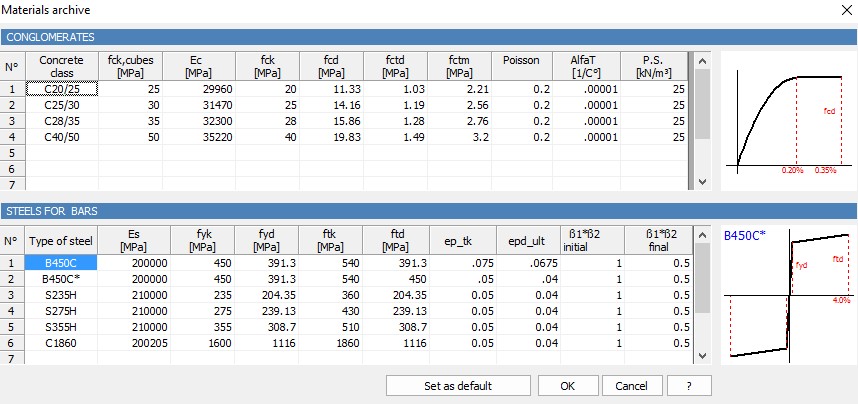To this unique materials archive refer all the sections of the structural elements planned in the programme. Each of the data appearing in the tables by default can be changed (also for the considerations developed afterwards) and do not constitute any vehicle for the designer as the only person responsible for the values assumed.
NB: In order to delete any kind of conglomerate amongst the ones expounded in the table, you only have to delete all the characters present in the box of Concrete Class column.
The environment through which it is possible to mange the materials archive is the following:

Window for the management of the structural materials
Conglomerates Data
•Concrete Class
The conglomerate class must have a standard designation included amongst the indicated ones: C20/25; C25/30; C28/35; C35/45 etc., defined on the basis of the characteristic cylinder compressive strength fck and Rck compression resistance to crushing of sample cubes (expressed in MPa).
•fck, cubes [MPa]: This is the characteristic compression strength Rck on cubes to refer to in the course of the project.
•Ec [MPa]: This is an elastic module of the concrete to be used in the course of the planning Ec = 220000 [(fck+8)/10]0.3
•fck [MPa]: This is the characteristic cylindrical compression strength which on the other hand appears as the first term in the standard designation of the class. In order to pass from the cubic to the cylindrical strength, the expression to be used is fck = 0.83 · Rck
•fcd [MPa]: This is the calculation strength of the conglomerate corresponding to acc ·fck / γc where acc is the reduction coefficient for long-lasting strengths and is normally 0.85 and γc = 1.50 is the partial coefficient of concrete. For level elements (slabs, walls, etc.) with thicknesses lower than 5 cm and realized in place the fcd value must be reduced by 20%.
•fctd [MPa]: This is the calculation tensile strength equal to: fctk / γc = 0.7 fctm / γc
•fctm [MPa]: This is the average tensile strength equal to 0.3fck2/3
•Poisson: The value of the Poisson ration can vary from 0 (cracked concrete) to 0.2 (non-cracked concrete). The programme uses this coefficient for the calculation of the tangential modulus of elasticity G = 0.50 · Ecm (1+m)
•AlfaT [1/C°]: Thermal expansion coefficient.
•P.S.[KN/m³]: Unit weight of reinforced concrete. It is used by the programme for the calculation of the weights peculiar to the structural elements.
Steels bars data
•Steel Type for reinforced concrete structures, a single steel type can be used.
•Es [MPa]: Modulus of elasticity of steel.
•fyk [MPa]: Characteristic yield stress assumed in the course of the project corresponding to the rated one 450 N/mm².
•fyd [MPa]: Calculation yield stress assumed in the course of the project corresponding to fyk /γs where γs is the partial coefficient of steel.
•ftk [MPa]: Characteristic breaking stress assumed in the course of the project corresponding to the rated one (540 MPa).
•Ftd [MPa]: Calculation breaking stress assumed in the course of the project. It can be assumed as equal to fyd (null work-hardening) or to fyd ·k where k = ft / fy. This ratio cannot be lower than 1.15 or higher than 1.35. Prudentially, k = 1.15 can be assumed.
•ep_tk: Characteristic unit strain at failure. Its value cannot be lower than 0.075.
•epd_ult: Ultimate calculation deformation corresponding to eud = 0.9 euk
•β1·β2 init.: Steel-concrete adherence coefficient on the first application of the load. It is used by the software in the checking of the cracks in the infrequent operating combinations (SLE, limit operativeness state).
•β1·β2 init.: Steel-concrete adherence coefficient for long-lasting loads. It is used by the program in the checking of the opening of the cracks in the frequent and quasi-permanent operating combination (SLE). Limit operativeness states parameters (Opening of cracks – Normal strains).
Limit operativeness states parameters (Opening of cracks – Normal strains).
•Opening of cracks: In this column are reported the limit values relevant to the opening of cracks fixed according to the limit state and to the fixed environmental conditions (these latter must be indicated in the General Data window).
•S.Cls [aliq. fck]: Limit strain of the operating concrete expressed as a rate of the characteristic breaking stress of concrete.
•S.Fe [aliq. fyk]:Limit strain of the operating steel expressed as a rate of the characteristic breaking stress of steel.
© GeoStru